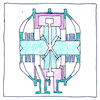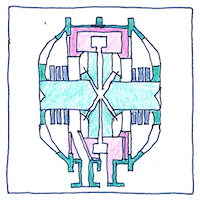Henry Cavendish,
Kristian Birkeland,
Sam Eyde
chemistry

|
Birkeland-Eyde process
The bacterium Rhizobium in roots of legumes fixes molecular nitrogen into nitrates. Henry Cavendish showed how to use electric sparks to split molecular nitrogen to create nitrates. Kristian Birkeland and Sam Eyde developed an industrial process using Cavendish’s method. Lightning flashing in the atmosphere splits molecular nitrogen producing nitrates by the same process.
Nitrogen fertilizer
Nitrogen is required for growing leaves. The manufacture of nitrogen fertilizer based on synthesized ammonia replaced mining of saltpeter or guano, nearly doubled the global population, and supports a third of the food produced today.
Spark of being
Only a spark distinguishes the constituents of life from simple living things. Separating by analysis the conjunction of simple parts identifies the missing element. To separate nitrogen from nitrogen Cavendish used a simple spark. To give her monster life Mary Shelley prescribed “a spark of being.”



About 78% of our atmosphere is dinitrogen, also called molecular nitrogen (N2). Because each pair of nitrogen atoms bound together with triple bonds, dinitrogen is inert. All living organisms depend on atomic nitrogen, but to make it useful biologically, dinitrogen must be split. The energy it takes to split dinitrogen is released when the separate atoms are allowed to recombine, which makes nitrogen useful for propellants and explosives.
See also in The book of science:
Readings in wikipedia: